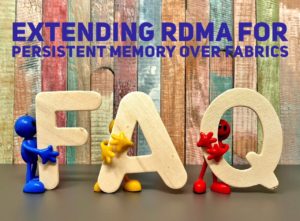
Category: RDMA


Got SPDK Questions?
Author of NVMe™/TCP Spec Answers Your Questions
900 people have already watched our SNIA Networking Storage Forum webcast, What NVMe /TCP Means for Networked Storage? where Sagi Grimberg, lead author of the NVMe/TCP specification, and J Metz, Board Member for SNIA, explained what NVMe/TCP is all about. If you haven’t seen the webcast yet, check it out on-demand.
/TCP Means for Networked Storage? where Sagi Grimberg, lead author of the NVMe/TCP specification, and J Metz, Board Member for SNIA, explained what NVMe/TCP is all about. If you haven’t seen the webcast yet, check it out on-demand.
Like any new technology, there’s no shortage of areas for potential confusion or questions. In this FAQ blog, we try to clear up both.
Q. Who is responsible for updating NVMe Host Driver?
A. We assume you are referring to the Linux host driver (independent OS software vendors are responsible for developing their own drivers). Like any device driver and/or subsystem in Linux, the responsibility of maintenance is on the maintainer(s) listed under the MAINTAINERS file. The responsibility of contributing is shared by all the community members.
Q. What is the realistic timeframe to see a commercially available NVME over TCP driver for targets? Is one year from now (2020) fair?
Read MoreNetworking Questions for Ethernet Scale-Out Storage
 Unlike traditional local or scale-up storage, scale-out storage imposes different and more intense workloads on the network. That’s why the SNIA Networking Storage Forum (NSF) hosted a live webcast “Networking Requirements for Ethernet Scale-Out Storage.” Our audience had some insightful questions. As promised, our experts are answering them in this blog.
Q. How does scale-out flash storage impact Ethernet networking requirements?
A. Scale-out flash storage demands higher bandwidth and lower latency than scale-out storage using hard drives. As noted in the webcast, it’s more likely to run into problems with TCP Incast and congestion, especially with older or slower switches. For this reason it’s more likely than scale-out HDD storage to benefit from higher bandwidth networks and modern datacenter Ethernet solutions–such as RDMA, congestion management, and QoS features. Read More
Unlike traditional local or scale-up storage, scale-out storage imposes different and more intense workloads on the network. That’s why the SNIA Networking Storage Forum (NSF) hosted a live webcast “Networking Requirements for Ethernet Scale-Out Storage.” Our audience had some insightful questions. As promised, our experts are answering them in this blog.
Q. How does scale-out flash storage impact Ethernet networking requirements?
A. Scale-out flash storage demands higher bandwidth and lower latency than scale-out storage using hard drives. As noted in the webcast, it’s more likely to run into problems with TCP Incast and congestion, especially with older or slower switches. For this reason it’s more likely than scale-out HDD storage to benefit from higher bandwidth networks and modern datacenter Ethernet solutions–such as RDMA, congestion management, and QoS features. Read More
RDMA for Persistent Memory over Fabrics – FAQ
 In our most recent SNIA Networking Storage Forum (NSF) webcast Extending RDMA for Persistent Memory over Fabrics, our expert speakers, Tony Hurson and Rob Davis outlined extensions to RDMA protocols that confirm persistence and additionally can order successive writes to different memories within the target system. Hundreds of people have seen the webcast and have given it a 4.8 rating on a scale of 1-5! If you missed, it you can watch it on-demand at your convenience. The webcast slides are also available for download.
We had several interesting questions during the live event. Here are answers from our presenters: Read More
In our most recent SNIA Networking Storage Forum (NSF) webcast Extending RDMA for Persistent Memory over Fabrics, our expert speakers, Tony Hurson and Rob Davis outlined extensions to RDMA protocols that confirm persistence and additionally can order successive writes to different memories within the target system. Hundreds of people have seen the webcast and have given it a 4.8 rating on a scale of 1-5! If you missed, it you can watch it on-demand at your convenience. The webcast slides are also available for download.
We had several interesting questions during the live event. Here are answers from our presenters: Read More
Introducing the Networking Storage Forum
At SNIA, we are dedicated to staying on top of storage trends and technologies to fulfill our mission as a  globally recognized and trusted authority for storage leadership, standards, and technology expertise. For the last several years, the Ethernet Storage Forum has been working hard to provide high quality educational and informational material related to all kinds of storage.
globally recognized and trusted authority for storage leadership, standards, and technology expertise. For the last several years, the Ethernet Storage Forum has been working hard to provide high quality educational and informational material related to all kinds of storage.
From our “Everything You Wanted To Know About Storage But Were Too Proud To Ask” series, to the absolutely phenomenal (and required viewing) “Storage Performance Benchmarking” series to the “Great Storage Debates” series, we’ve produced dozens of hours of material.
Technologies have evolved and we’ve come to a point where there’s a need to understand how these systems and architectures work – beyond just the type of wire that is used. Today, there are new systems that are bringing storage to completely new audiences. From scale-up to scale-out, from disaggregated to hyperconverged, RDMA, and NVMe-oF – there is more to storage networking than just your favorite transport. Read More